
views
X
Trustworthy Source
Centers for Disease Control and Prevention
Main public health institute for the US, run by the Dept. of Health and Human Services
Go to source
They may be creepy and annoying, but you aren’t going to get sick from the bites. There are a variety of ways to kill bed bugs, but the best way to do it is to hire a professional exterminator. Since bed bugs tend to be resilient and adept at hiding, it can be pretty tough to treat the problem yourself. It can certainly be done, but it may take several attempts to completely solve the problem.
Exposing Bugs to Heat or Cold
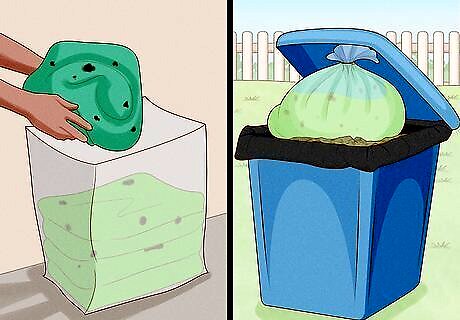
Package your machine-washable clothes and sheets in airtight garbage bags. Take all of the clothes in your laundry basket and collect them in separate garbage bags. Use the drawstrings on each bag to tie it tight and wrap the top of each bag in a knot. Repeat this process for your sheets and blankets, as well as all of the clothes in your drawers.Tip: Encase your mattress and box spring in protective bags and close the zippers as soon as you’ve removed the sheets and blankets. The mattress typically holds 50-70% of the bed bugs in any given infestation. Bagging your mattress and box spring will suffocate the bugs over time and you won’t need to worry about it. You likely do not need to worry about clothes hanging up. This will keep the bugs on your clothes and sheets from creeping out and spreading to other parts of your home.
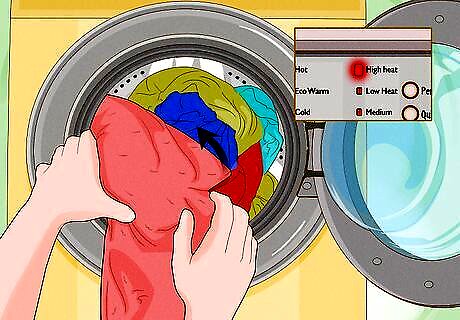
Wash and dry your machine-washables on high heat to kill the bed bugs. Take your bags to your washing machine and pour them directly into the drum. Add your laundry detergent and wash all of your clothes and sheets in hot water. When they’re done, dry them on high heat. This will kill any bugs that are trapped in your clothes and sheets. You can take your bags to a laundromat if you don’t have a washing machine at home. You do not need to worry about spreading the infestation at the laundromat so long as you keep your clothes bagged and empty them directly into the washing machine.
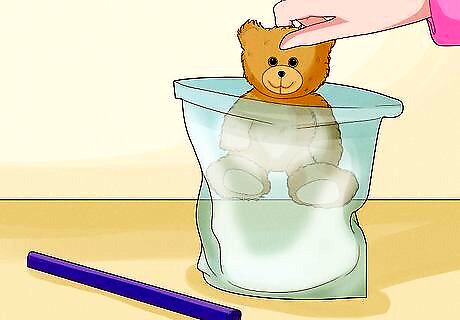
Place any unwashable fabric items in airtight freezer bags. If you have fabric-lined items or stuffed objects in your room, place them inside airtight freezer bags. Push the air out of the bag and use the zipper to seal the bag. This applies to teddy bears, hats, hacky sacks, desk trinkets, and any other items that aren’t made entirely out of metal or plastic.
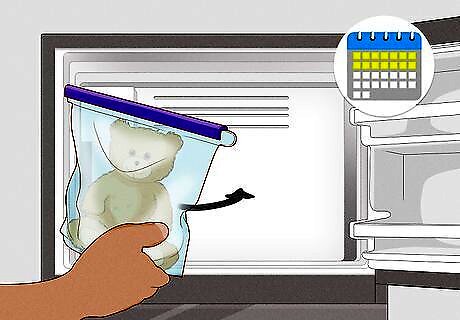
Leave the bags in your freezer for 14 days to kill any bugs. Set each plastic bag inside of your freezer. Let it sit inside the freezer for at least 14 days to freeze any bugs and eggs to death. After 14 days, take the objects out of the freezer and place them in a clean part of your home while you handle the rest of the infestation. Use your big deep freezer to do this if you have one. If your freezer is packed, empty out your ice, thaw any food to eat it in the next 1-3 days, and toss the rest of it out. You may need to do this in waves if you have a lot of items to freeze and you’re tight on space.
Vacuuming and Steaming Items
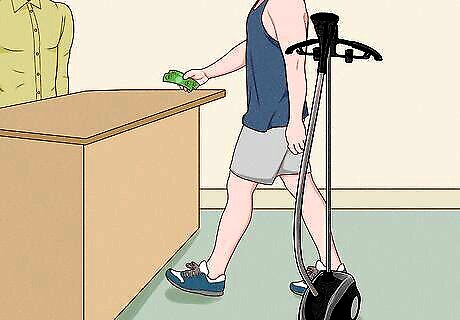
Buy or rent a high-powered steamer to destroy bugs on contact. A steamer will kill any bugs that come into contact with it. Buy or rent a steamer that can get at least 130 °F (54 °C), which is the temperature point where bed bugs die on contact. If you want to rent the steamer, contact a cleaning supply store or construction supply store. It shouldn’t cost more than $20 a day to rent. This process will not eradicate the infestation, but it will make it much easier to treat the problem. This is technically a heat treatment, but the vacuuming and steaming have to go together. The vacuum will lift up all of the dead bugs you kill with the steamer.
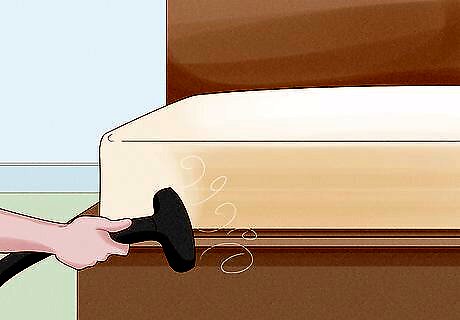
Run the steamer over the surface of high-risk areas to kill the bugs. Turn the steamer on and turn it to the highest temperature setting available. Run the hose over the bed frame, drapes, carpeted areas, and baseboards to instantly kill any bed bugs. This won’t kill every single bug, but it will make it much easier to deal with the rest of the infestation. If you see a lot of dead bugs all over the place when you’re done, vacuum them up and discard the bag immediately.
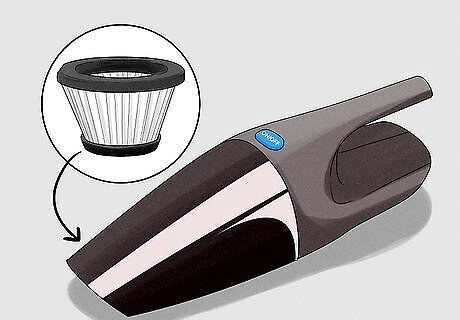
Use a high-powered vacuum with a HEPA filter to suck bugs up. Get a high-powered vacuum with a HEPA filter. The HEPA filter will lock any bugs you’re going to suck up inside of the bag and make it much easier to dispose of them. You can use a regular vacuum if you prefer, but you’ll need to empty it out right away and you may end up accidentally spreading the infestation.
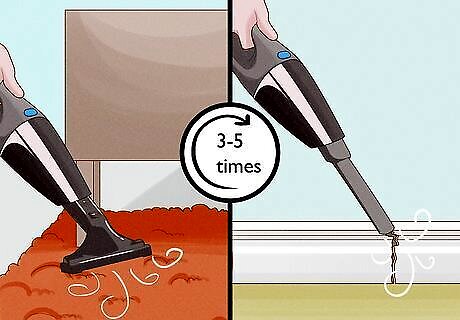
Run the vacuum over the carpet, drapes, bed frame, and baseboards. Turn the vacuum on high and vacuum your bedroom and closet floors. Cover any carpeted areas 3-5 times to clean them thoroughly. Use a thin hose attachment to vacuum the cracks in your walls, baseboard, drapes, and bed frame. Run the hose attachment over every heavily-infested area 4-5 times.Tip: With the HEPA filter, you can leave the vacuum alone and let the bugs suffocate inside. Alternatively, you can empty the bag into a garbage bag, tie the top off, and toss it out immediately.
Applying Pesticides in Your Home
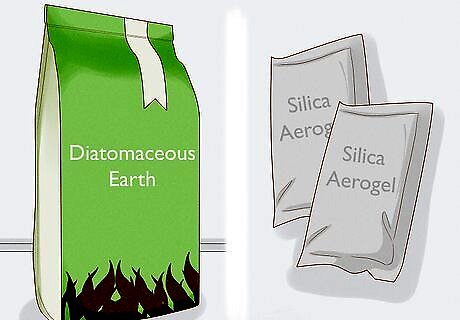
Buy silica aerogel or diatomaceous earth to kill the bed bugs. Bed bugs are pretty resilient and there are only 2 commercial pesticides that are effective. Silica aerogel is a sticky powder-like substance that attaches to bed bugs that walk over it and suffocates them. Diatomaceous earth is a powder that kills bugs that come into contact with it. Both options are nontoxic to humans so long as you don’t cover your skin in it. While both silica aerogel and diatomaceous earth are nontoxic, you’re still better off wearing rubber gloves and a dust mask when you apply them just to keep the chemicals off of you. Keep any pets or children out of the rooms you’re treating. Foggers and bug bombs are not effective against bed bugs. It really seems like they would be, but bed bugs are pretty adept at hiding in microscopic cracks and nooks. Many of the bugs will survive if you go this route. If you get diatomaceous earth, use the food-grade version to kill the bugs. While the pesticide versions are nontoxic so long as you don’t rub it into your skin, the food-grade stuff is completely safe. Regular pesticides that kill ants, wasps, and other common bugs won’t do anything to bed bugs.

Load a duster with the pesticide or snip the tip on the bottle. The easiest way to efficiently apply pesticide is with a duster. Put your gloves and dust mask on and untwist the cap on the duster’s tank. Fill it halfway with the pesticide and close the lid to finish loading it. You can also apply the insecticide from the bottle by snipping the top ⁄4 inch (0.64 cm) off of the nozzle with scissors. There’s nothing wrong with using the bottle instead of a duster; it’s just a little harder to get an even spread when you squirt the pesticide out. The silica aerogel is only sticky to the bugs. It will look like a powder to you and won’t stick to your furniture.
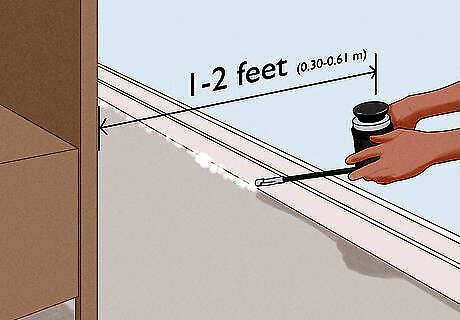
Squirt the pesticide into cracks in the walls and along the baseboards. Pull all of your furniture 1–2 feet (0.30–0.61 m) away from the wall. Walk around the infested room and squirt a puff of pesticide along each portion of the baseboard. Squirt 2-3 puffs into any cracks in your walls, which are common hiding spots for bed bugs. It can be tempting to just completely coat the room in this stuff. This won’t be any more effective than targeting the problematic areas though, and all you’ll do is make a bigger mess for yourself. Bed bugs drink blood to survive. As a result, you’ll only see them in rooms where people sleep. Unless you’ve seen bed bugs outside of your bedroom, you only need to treat your bedroom and closets.

Spread pesticide inside your drawers and around your bed frame. Empty out all of your drawers and pack the clothes in airtight plastic bags if you haven’t already. Then, place 4-5 squirts along the corners of each drawer. Spray some of the pesticide around every leg on your bed frame. This will catch any bed bugs that are hiding during the day but come out at night to feed. If you have any carpets, give them a spritz as well. If the entire room is carpeted, spread a 1–2 feet (0.30–0.61 m) wide layer of pesticide around every baseboard, piece of furniture, and fixture in the room. You do not need to cover your clothes in pesticide. Washing, drying, and keeping the clothes out of the infested room will keep them bug-free.
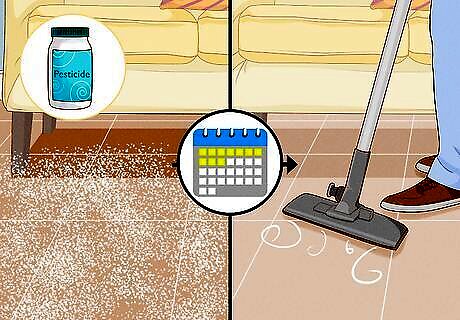
Leave the pesticide for at least 10 days before vacuuming it up. The longer you can leave the pesticide out, the better. At a bare minimum, leave the powder on the ground and in your drawers for 10 days. Then, vacuum up the powder. If the bed bugs reappear, which is not particularly unlikely, repeat this entire process.Tip: It takes 10 days for eggs to hatch, which is why you need to leave the pesticide out for at least 10 days. If you vacuum the powder up before 10 days have passed, the infestation may come back immediately. Bed bugs are notoriously resilient. It may take 3-4 attempts to clear out the infestation entirely. Luckily, your odds of success increase with each attempt. You can take 10 days off to stay with a friend if you’d like, but you can stay in the same room as the pesticide. Just try to walk around the powder and keep children and pets out of the room. Keep your windows closed and fans off while you’re leaving the pesticide out. If your room gets a lot of air, it could blow the pesticide away.
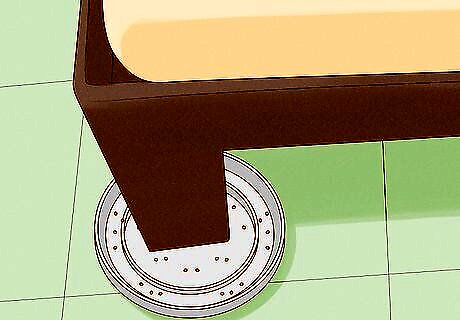
Place bed bug interceptors around your bed frame to keep bed bugs off. Bed bug interceptors are small traps that attract bed bugs and keep them inside. Set down 2-3 interceptors around each leg of your bed frame to catch any bugs that try to sneak up and feed while you sleep. This is also a great way to see how effective your pesticide is, since you can check the traps in the morning and see how many bugs you caught. If you’re waking up with bites but you don’t see any bugs in the interceptors, there’s a hole in your mattress encasement or your sheets are infested. Re-bag your mattress and wash and dry your sheets. If you don’t have a bed frame, get one. It’s incredibly hard to fight a bed bug infestation if your mattress and box spring are on the floor.
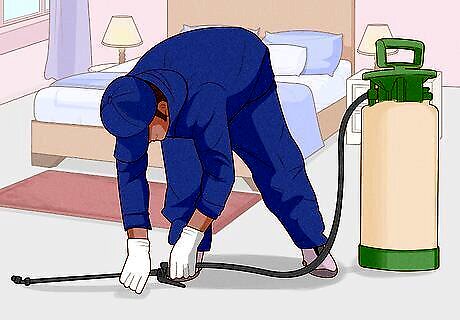
Hire a professional to handle a severe infestation. The best way to deal with bed bugs is to hire a professional exterminator. They will check your furniture, bed, carpets, and baseboards to determine the best course of action. They’ll also walk you through what they’re going to do to kill the bed bugs. Pack your bags and spend 1-2 days at a hotel or friend’s house to give the exterminator space to work. This is really the only way to know with 100% certainty that the bed bugs have been eradicated. Unfortunately, it can cost $500-2,000 to treat an infestation depending on the severity. Once the problem is thoroughly dealt with, you’ll be able to return to your bug-free home and rest easy knowing they’re gone.










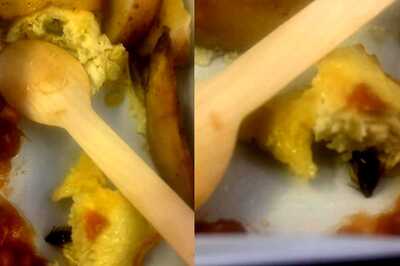




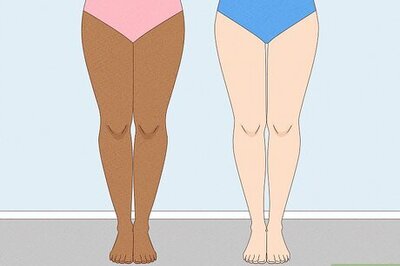
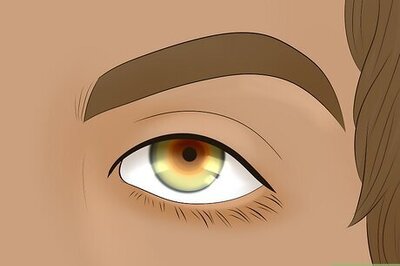



Comments
0 comment